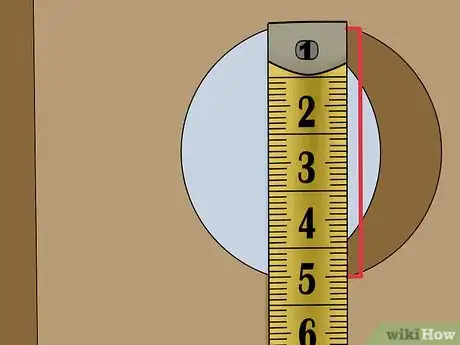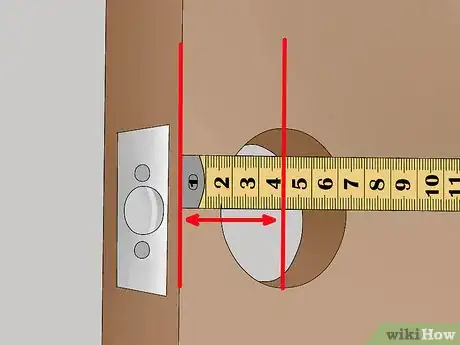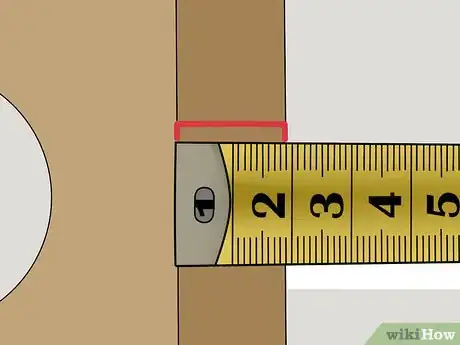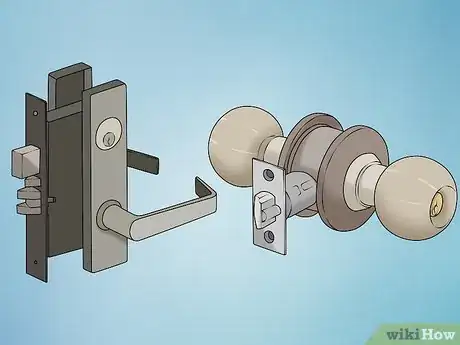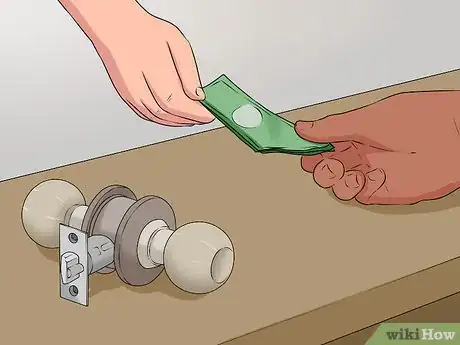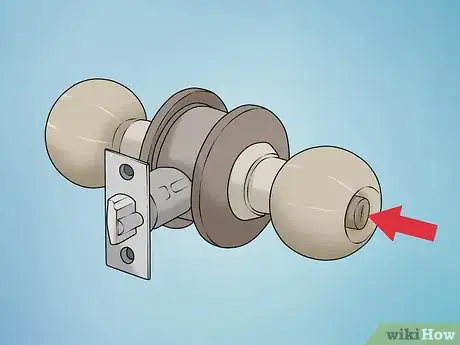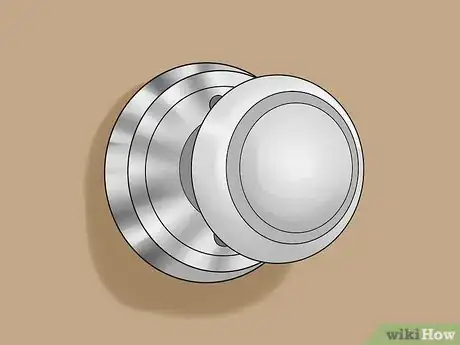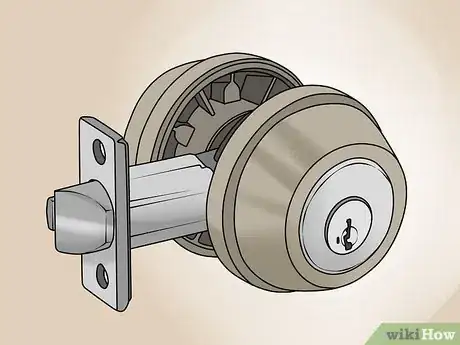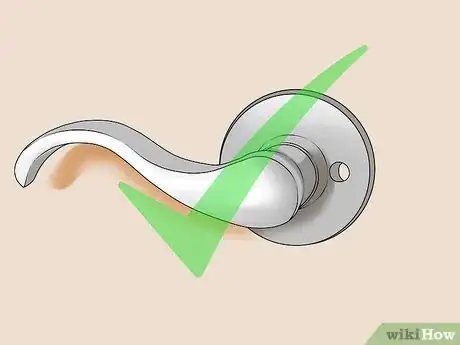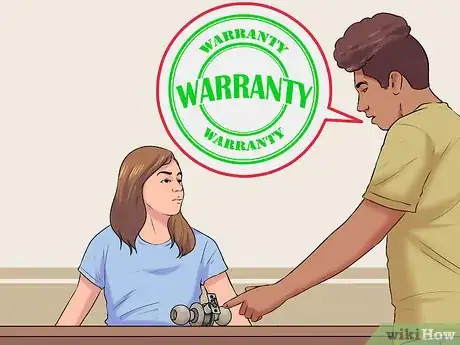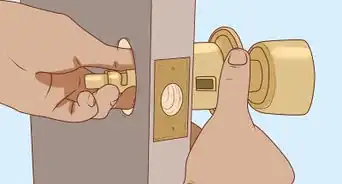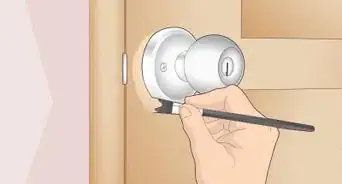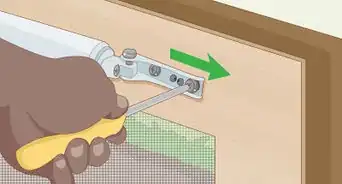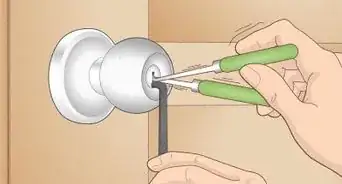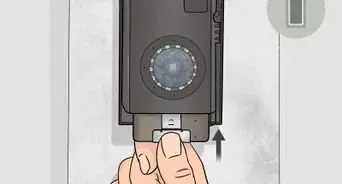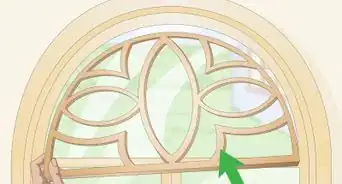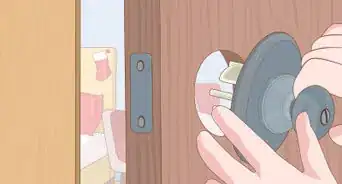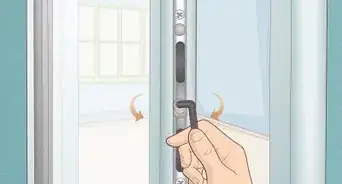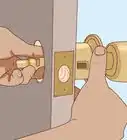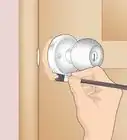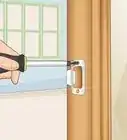This article was co-authored by Mark Spelman. Mark Spelman is a General Contractor based in Austin, Texas. With over 30 years of construction experience, Mark specializes in constructing interiors, project management, and project estimation. He has been a construction professional since 1987.
This article has been viewed 132,393 times.
Finding the right doorknob might seem difficult at first. However, your search only requires consideration of a few factors. Focusing on location, function, and style will allow you to choose fitting doorknobs for your rooms.Whether you are maintaining your doors or decorating them, you can find doorknobs that will fit your purpose.
Steps
Measuring Your Door
-
1Measure the bore hole. You'll need to know the bore hole's diameter to get the right sized knob. Measure across the circular hole at its widest point, i.e. start at the bottom of the hole and pull the tape until you hit the top of the hole. There's your diameter. Write down the number of inches that you see on a small notepad for reference.
-
2Measure the backset. The backset is space between your bore hole and the door's edge.[1] Typically this is either 2 3/8 or 2 ¾ inches. Place your measuring tape on the center of the hole and pull it till you hit the door's edge. Note this measurement on a notepad or post-it note.Advertisement
-
3Check your door's thickness. Start measuring at the left edge of the door until you reach the door's right edge. Note this measurement. Interior doors are often around 1 3/8 inches (3.5 cm) thick.[2] Exterior doors usually measure about 1 3/4 inches (5 cm) thick. Make sure the door you will be placing the doorknob on is of average thickness; otherwise, you will need to purchase special hardware.
Choosing a Doorknob and Lock
-
1Choose a lockset. Generally, locksets fall into two main categories: mortise and cylindrical. The former has a rectangular body that will glide into a similarly shaped pocket. The latter has a rotund body that slips into a bore hole and connects with the latch bolt. Mortise locksets are generally found in warehouses and industrial sites. Cylindrical locksets are used in a wider range of domestic,residential spaces than mortise locksets.
- There are also electronic locks, which function through the use of an electric current.[3] You would generally use an electronic door knob for the exterior of your house. Generally, you can choose between a keypad or a key opening.
-
2Purchase a passage knob to connect rooms. These are usually used for rooms that do not need to be locked or closets. You would generally use a passage knob for storage and laundry rooms. For example, if you have a room in your basement that you use to store your stuff, you might use a passage knob for that door. Remember, these usually do not lock. In fact, they do not have keyed cylinders or locking mechanisms. [4]
-
3Get a privacy knob for solitude. Privacy knobs are generally used for bedrooms and bathrooms. Privacy knobs have a locking mechanism located on the inside of the room. The main goal of a privacy knob is to prevent outside access. Sometimes these knobs have a button you can push located on the section of the doorknob that would be inside the room. You will probably also receive a pin or specialized key that can open the door from the outside.
-
4Decorate with a dummy knob. A “dummy” knob is a knob that does not have a formal function. It exists mainly for decorative purposes. It can be difficult to tell it apart from a door knob with a formal function.[5] Dummy knobs are placed on the surface of doors, and do not penetrate the door. Dummy knobs are often used for closets and cabinets. For example, you might get a dummy knob for a wardrobe closet in your house or for double doors.
-
5Secure your house with an exterior knob. This doorknob is placed on the outside of a door. You would generally use this for the entryway to your house. This doorknob has a locking mechanism called a deadbolt. A deadbolt uses a throw bolt that is pushed into the door jamb to solidly lock a door. The type of dead bolt you should choose will depend on how secure you want your door to be.
- Buy a single cylinder deadbolt. This type of deadbolt's usage will depend on the doorknob. You would open this doorknob with a key on the outside and a thumb turn on the inside. This is less secure than a double-cylinder because if there is an open window next to the door, you can reach in and open the door from the outside.
- Buy a double cylinder deadbolt. This type of deadbolt is unlocked with a key on both sides. It cannot be opened by a robber who breaks your window and tries to open your door from the inside.[6]
Purchasing a Doorknob
-
1Coordinate style to function. Perhaps your doorknob is going to be used for your storage room, and you want a utilitarian design. Maybe, you may want a beautiful doorknob for every room of your house. Either way, you need to verify that you are choosing a style that matches the doorknob's function. So avoid ornate styles that might impede a doorknob's functionality. Conversely, you may want to go with a more decorative design for a knob that will be seen often.
-
2Choose a finish. When you begin searching through doorknob listings or glancing at doorknobs in the store, you will probably notice that each doorknob has a distinct finish. Common doorknob finishes are white metal, brass, iron, bronze, satin nickel, chrome, and oil-rubbed bronze. Choosing a finish will depend on both aesthetic taste and location. For example, you may want to go with chrome bathroom doorknob because it is easy to clean.
-
3Search widely. Once you have an idea of what you are looking for, shop for doorknobs in retailers that carry them. Try major chain stores such as Lowe's and Home Depot, or department stores such as Walmart and Sears. Check online for larger selections – the best prices are also often online. Search online retailers such as Amazon and eBay for new and used doorknobs. These sites will often offer free shipping and special deals. Check your local hardware store as well.
-
4Research return policies and warranties. Make sure you are able to return or exchange your doorknob if you do not like it, or if it does not fit your door. Ask if a warranty is included in the price.
Things You'll Need
- Tape measure
- Notepad
- Camera
References
- ↑ http://www.directdoorhardware.com/door_hardware_guide.htm
- ↑ http://www.directdoorhardware.com/door_hardware_guide.htm
- ↑ http://www.hometips.com/buying-guides/doorknobs-lock-sets.html
- ↑ http://www.directdoorhardware.com/door_hardware_guide.htm
- ↑ https://www.baldwinhardwaredirect.com/shop/pc/catalog/pass%20and%20priv.pdf
- ↑ http://www.directdoorhardware.com/deadbolts.htm
About This Article
When you’re buying a new doorknob, you’ll want to get one the right size and style for your door. Mortise locksets are rectangular with a handle and fit into a rectangular gap in your door. Cylindrical locksets are more common in households and fit inside a circular hole in your door. If you don’t need the door to lock, choose a passage doorknob. For rooms you want to lock, choose a privacy knob, which has a locking mechanism inside it. To make sure your doorknob fits in your door, take some measurements before you head to a store. You’ll need to measure the hole the knob goes through, the door thickness, and the space between the hole and the edge of the door. For more tips from our Home Improvement co-author, including how to choose the finish of your doorknob, read on!
